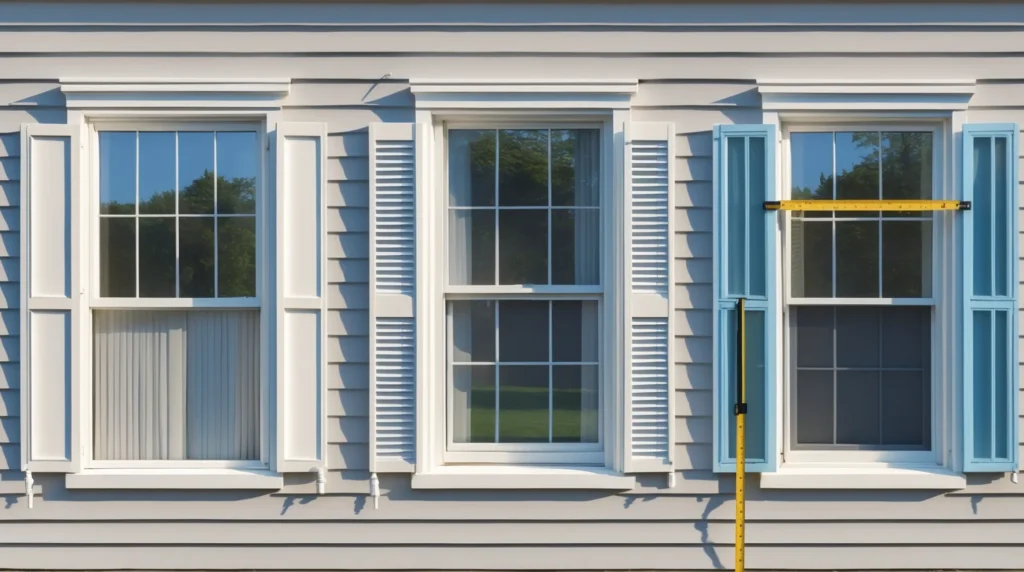Exterior shutters can transform the look of a home, but only if they are measured correctly. A poor fit makes shutters look out of place, even if they are made from the finest materials. This guide gives a clear, step-by-step answer to how to measure for exterior shutters while also exploring size rules, charts, and expert tips. You’ll learn about proportions, mounting styles, and common mistakes to avoid. By the end, you’ll have the knowledge needed to measure with confidence and choose shutters that enhance curb appeal.
Why Correct Shutter Measurements Make All the Difference
Shutters are more than decoration. Historically, they protected windows from storms and gave privacy. Today, most are used for style, but measurements still matter. If shutters don’t align with the window size, they draw negative attention instead of adding charm.
Think of it like a suit or dress if the fit is wrong, even an expensive piece looks cheap. The same happens with shutters. When sized correctly, shutters look like they could close over the window, even if they are decorative. This natural balance brings harmony to the home’s design.
Correct shutter measurements also save money. Ordering the wrong size means returns, delays, and wasted energy. A little extra care upfront ensures a smooth installation and lasting results.
Standard Exterior Shutter Sizes and Window Proportions Explained

Most shutter manufacturers follow common size ranges to fit the majority of windows. Heights usually begin at 36 inches and go up in two-inch increments, sometimes reaching 80 inches or more for tall windows. Widths often fall between 12 inches and 18 inches, which cover the most common window styles.
However, not all windows are “standard.” Older homes, custom builds, or historic properties may have unique window shapes. That’s why measuring is always necessary. Don’t assume your window matches a catalog size.
When thinking about proportions, remember this simple rule: shutters should frame the window, not fight with it. If a window is tall and narrow, shutters should also appear tall and narrow. For wide windows, balance is created with slightly wider shutters. This proportional harmony gives the home a polished and timeless look.
How to Measure for Exterior Shutters Step by Step
Here’s the step-by-step method to get it right the first time:
-
Height measurement: Measure from the very top of the window opening to the very bottom. Always include the frame if you want shutters to align with it. The shutter length should match this measurement exactly.
-
Width measurement: Measure the full width of the glass area, not including trim. Divide by two. This gives the correct shutter width, since two shutters should appear to close over the window.
-
Check for squareness: Not all windows are perfect rectangles. Measure the height at both sides and the width at both the top and bottom. Use the larger measurement when in doubt.
-
Record carefully: Write each measurement down and double-check before ordering. A simple half-inch error can create costly mistakes.
By following these steps, you’ll know exactly how to measure for exterior shutters. The process is straightforward, but accuracy is key.
Shutter Size Guide for Length, Width, and Proper Fit
This exterior shutter size guide will make decisions easier:
-
Length: Always match the window’s height. For example, if your window is 60 inches tall, your shutter length should also be 60 inches.
-
Width: Divide the window’s width in half. If a window is 30 inches wide, each shutter should be 15 inches.
-
Balance: Avoid extremes. Shutters that are too wide can make windows look squeezed. Shutters that are too narrow look like sticks.
Pro Tip: Stand back from your house and imagine the shutters closed. Do they look like they could cover the window? If yes, you’ve chosen the right size.
Rules for Exterior Shutters and Common Sizing Questions
Shutter sizing rules are simple but important:
-
Should shutters be longer than the window? No. They should match the exact height of the window opening. Longer shutters look unnatural.
-
How wide should shutters be? About half the window width. This gives the appearance that the shutters can close properly.
-
How big should shutters be overall? Big enough to match the window’s proportions, but never so big that they overlap trim or siding details.
-
What size shutters work for exterior windows? Always use the formula: shutter length = window height, shutter width = half window width.
Following these rules gives you shutters that look authentic and well-proportioned, adding value to your home instead of distracting from it.
Measuring Shutters for Windows Inside vs. Outside Mount
Inside Mount:
-
Shutters fit within the window opening.
-
Requires very precise shutter measurements.
-
Works best for windows with deep frames.
Outside Mount:
-
Shutters overlap the window trim.
-
More forgiving but still requires accurate measuring.
-
Ideal for windows without deep frames.
Which should you choose?
Most homeowners prefer outside mount for decorative shutters because it allows for a clean, full-frame appearance. Inside mount is less common but may suit historic or specialty homes. Always measure both top and bottom widths, as even small unevenness can affect the final fit.
Avoiding Mistakes When Measuring Exterior Window Shutters

Here are the most common mistakes and how to avoid them:
-
Not including trim in height. Always measure to the full frame to keep shutters aligned.
-
Assuming windows are square. Measure both sides to check. Some windows lean slightly.
-
Forgetting symmetry. Both shutters must be identical in width, or they’ll look mismatched.
-
Going too wide. Wider than half the window width creates an unbalanced look.
-
Ordering based on guesswork. Always measure. Never assume your windows match “standard sizes.”
A small amount of care during measurement saves major headaches later.
Shutter Size Chart Quick Reference for Homeowners
Here’s a helpful shutter size chart:
Window Height → Shutter Length
-
36″ window → 36″ shutter
-
48″ window → 48″ shutter
-
60″ window → 60″ shutter
-
72″ window → 72″ shutter
-
80″ window → 80″ shutter
Window Width → Two Shutters Width Each
-
24″ window → Two 12″ shutters
-
30″ window → Two 15″ shutters
-
36″ window → Two 18″ shutters
This simple guide removes confusion and keeps proportions correct every time.
Expert Guidance from Gallery Shutters Inc. in Southern California
Even with charts and rules, some homes need a professional touch. That’s where Gallery Shutters Inc. comes in. We have years of experience measuring, designing, and installing shutters. Our team knows how to work with unique windows, historic styles, and modern designs.
Homeowners in Southern California trust us because we combine craftsmanship with clear advice. We don’t just sell shutters; we make sure they fit perfectly and add value to your property. From choosing the right dimensions to handling custom projects, our experts guide you every step of the way.
Final Tips for Choosing the Right Shutters with Lasting Appeal
The golden rule: shutters should always look as if they could close over the window. That single principle helps guide every measurement.
When in doubt, use the formula:
-
Shutter length = window height
-
Shutter width = half window width
Add in a double-check for trim, squareness, and symmetry, and your shutters will fit beautifully. Remember that good shutters are an investment in both beauty and value.
Want help getting it right the first time? Call Gallery Shutters Inc. today. Our experts can measure, recommend, and install shutters that perfectly match your home’s style. Schedule your consultation now and enjoy the peace of mind that comes with a flawless fit.
